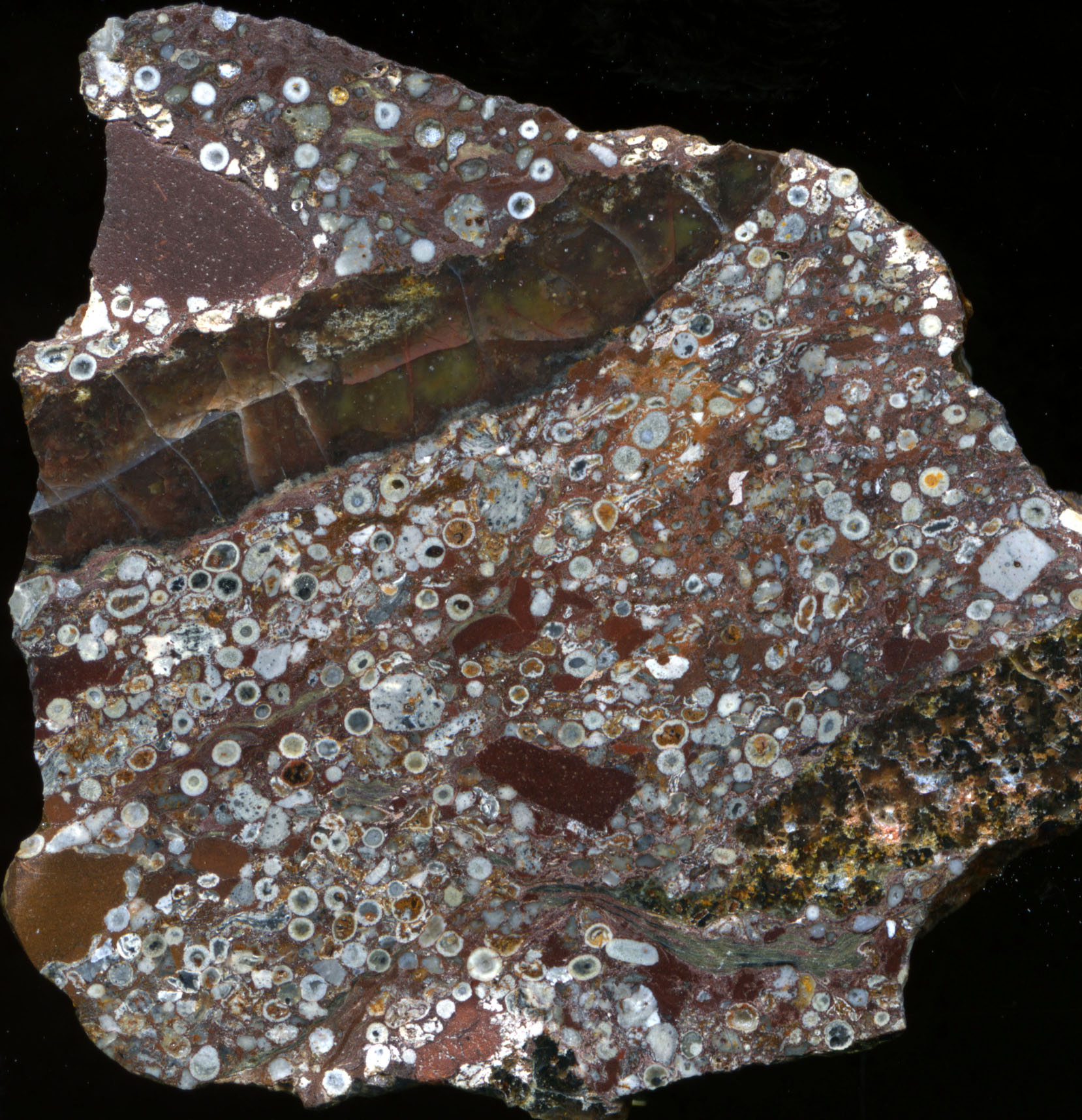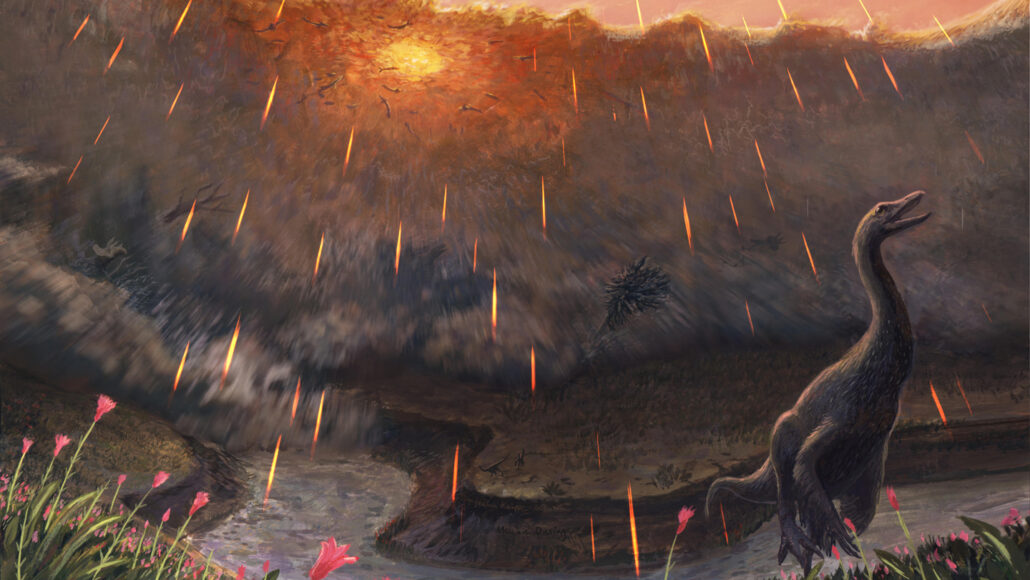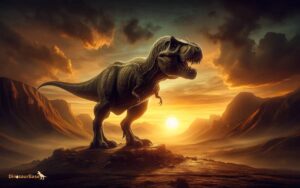Where Did Dinosaur Asteroid Hit: Unveiling the Impact Site
The asteroid that caused the extinction of dinosaurs struck near what is now the Yucatán Peninsula in Mexico. The impact site is known as the Chicxulub crater.
Millions of years ago, a colossal asteroid collided with Earth, marking a cataclysmic event in our planet’s history. This event, known as the Cretaceous-Paleogene extinction event, led to the demise of approximately 75% of the planet’s species, including the dinosaurs.
Scientists have extensively studied the 150-kilometer-wide Chicxulub crater, concluding that its creation played a pivotal role in this mass extinction. The crucial evidence from this impact offers insights into the Earth’s geological history and the evolutionary pathways that followed. Understanding the Chicxulub impact helps us comprehend the fragility of life on Earth and the potential threats from celestial objects.

Credit: www.purdue.edu

The Fateful Day: Dinosaur Extinction Event
The day dinosaurs vanished from the Earth marks one of history’s most dramatic moments. Called the Dinosaur Extinction Event, it was the turning point for life on our planet. A massive asteroid collided with Earth, leading to the end of the dinosaur era. Here, we’ll explore where this catastrophic impact occurred and its devastating effects.
Tracing The Cosmic Culprit
The asteroid that sealed the dinosaurs’ fate struck the Yucatan Peninsula in present-day Mexico. Researchers pinpointed the impact site to a town called Chicxulub, now associated with the Chicxulub crater.
Through advanced technology, scientists have studied layers of rock and sediment. They discovered unique minerals only produced under extreme conditions. This evidence confirms the massive impact event.
- Crater diameter: about 150 kilometers (93 miles)
- Estimated impact force: over a billion times the energy of the atomic bombs dropped on Hiroshima and Nagasaki
- Crater age: approximately 65 million years
The Global Aftermath
The asteroid collision had immediate and long-lasting effects. These ranged from a giant shockwave to gradual climate changes.
| Immediate Effects | Long-Term Effects |
|---|---|
|
|
Darkened skies from debris blocked sunlight, chilling the Earth. This “impact winter” led to food chain disruptions. Plants and phytoplankton suffered first, followed by herbivores and then carnivores. Such changes reshaped ecosystems forever.
Recovery took millions of years, with mammals eventually rising to dominate the planet. Our very existence may hinge on this ancient cataclysm.
Chicxulub Crater: Epicenter Of Disaster
The story of the dinosaurs’ demise starts at a place known as the Chicxulub Crater. This is where a massive asteroid struck Earth. The impact kicked off a series of catastrophic events. Scientists believe this was the final blow to the dinosaurs.
Locating The Ground Zero
The Chicxulub Crater is buried under Mexico’s Yucatan Peninsula. It was not easy to find. A clue came from unusual rock in the region. Researchers saw a massive ring structure in the Earth’s crust.
Here’s what they used to find it:
- Geophysical data from oil drilling
- Magnetic surveys from above
- Analysis of shocked quartz crystals
The site spans a whopping 150 kilometers. It remains one of the best-preserved large impact structures on our planet.
Geological Scars Of Impact
The asteroid left serious marks. We have dust layers worldwide with high iridium levels. This rare metal hints at an extraterrestrial cause.
The impact’s power is seen in:
- Huge tsunamis that reshaped coasts
- A global layer of spherules, or small glassy beads
- Complex networks of rock fractures beneath the crater
Studies of the crater show a peak ring, a central uplift, and multi-ring basins. The force of the impact would have been billions of times more powerful than an atomic bomb.
Unlocking Secrets Below The Gulf Of Mexico
Imagine peeling back the layers of the Gulf of Mexico to reveal secrets of an ancient catastrophe. Science has done just that, discovering the impact site of the asteroid that ended the reign of the dinosaurs.
Beneath The Waves: Discoveries
The quest to find the exact location of the asteroid strike led researchers to the Yucatan Peninsula. There, hidden beneath the waves, lies the town-sized scar—the Chicxulub crater. This underwater detective story unveils clues about the enormous power that reshaped Earth’s history.
- Geophysical mapping reveals the crater’s size and shape.
- Shock quartz and other minerals provide evidence of the intense impact force.
- Analysis of tsunami deposits tells a story of widespread destruction.
Core Samples And Crater Analysis
Scientists drilled into the crater’s heart to extract core samples. These samples unlock the event’s time-encapsulated mysteries and give a timeline of the Earth’s recovery.
| Depth | Material | Significance |
|---|---|---|
| Shallow | Sediment | Post-impact recovery |
| Mid | Broken rock | Immediate aftermath chaos |
| Deep | Melt rock | Impact fingerprint |
With each layer examined, our understanding of the dinosaur-asteroid event becomes clearer. This monumental discovery is not just about dinosaurs—it’s about piecing together our planet’s ability to endure and evolve after a cataclysmic event.
Decoding The Impact That Changed Earth’s History
The day the dinosaurs disappeared remains a puzzle to many. Scientists have unearthed clues about this catastrophic event. A massive asteroid crashed into our planet. This collision triggered a series of events that altered life on Earth forever.
Energy Of Collision
An unimaginable force was released that day. The asteroid was about 10 kilometers wide. It struck what is now the Yucatan Peninsula in Mexico.
- The impact site is called the Chicxulub crater.
- Energy released was over a billion times that of the atomic bombs on Hiroshima and Nagasaki.
- This energy sparked wildfires, triggered tsunamis, and ejected debris into the atmosphere.
Triggering A Mass Extinction
The asteroid’s impact started a long winter. Sunlight could not reach the Earth’s surface.
- Plants could not photosynthesize, leading to a food chain collapse.
- Over 75% of Earth’s species went extinct, including the mighty dinosaurs.
- Ocean life suffered too, as the sun’s rays could not penetrate the murky waters.
This event marked the end of the Cretaceous Period and the start of the Paleogene Period.
Modern Explorations: Technologies And New Findings
Scientists have long been fascinated by the asteroid that wiped out dinosaurs. Today, modern technology shines new light on this ancient mystery.
New technologies help scientists uncover secrets about the dinosaur-ending asteroid. We are stepping into the depths of Earth’s geology with high-tech tools.
Advancements In Deep-sea Research
Deep under the ocean, advancements in technology illuminate dark mysteries. Remotely operated vehicles (ROVs) and autonomous underwater vehicles (AUVs) now explore these depths.
- ROVs transmit live images from the seabed.
- AUVs map the ocean floor with precision.
- Sophisticated sonar systems reveal hidden structures.
- New drilling techniques allow for deeper sediment extraction.
These tools provide fresh perspectives on ancient impacts like the Chicxulub Crater.
Recent Discoveries At Chicxulub
Situated on the Yucatan Peninsula, new findings at the Chicxulub Crater unravel the asteroid’s secrets.
- Advanced core drilling has retrieved deep rock samples.
- These samples give clues on the impact’s power and effects.
- Researchers now understand the tsunami aftermath better.
Radar and seismic reflection techniques provide a more detailed crater image.
They reveal the asteroid’s trajectory and the crater’s true size.
| Discovery | Technology Used | Significance |
|---|---|---|
| Crater Size and Shape | Seismic Reflection | Insights into impact magnitude. |
| Impact Effects on Climate | Core Drilling | Data on debris and soot layers. |
| Post-impact Life Evidence | Sonar Mapping | Clues to earth’s recovery timeline. |

Credit: fastercapital.com
Legacy Of The Chicxulub Impact
The Chicxulub crater beneath the Gulf of Mexico marks the catastrophic end of the age of dinosaurs. Its story is one of fire, ash, and a mass extinction event that forever changed the course of life on Earth. Scientists unearth tales buried for 66 million years, revealing the power of celestial impacts and their role in shaping our planetary history.
Lessons For Humanity
The Chicxulub impact serves as a stark reminder of our planet’s turbulent past. It offers key insights into Earth’s geological resilience and the fragile balance of ecosystems. By understanding the effects of such events, humanity gains perspective on:
- Disaster Preparedness: Learning from past events arms us with strategies to mitigate the impact of future cosmic threats.
- Extinction Awareness: The rapid loss of species teaches us the importance of biodiversity conservation.
- Planetary Defense: This event underscores the need for global cooperation in monitoring and defending against asteroids.
Impact On Current Earth Science Studies
Studies of the Chicxulub crater continuously reshape our understanding of Earth’s geological processes and history. Research highlights include:
- Crater Formation: Insights into how large impacts can alter the planet’s surface and climate.
- Recovery Patterns: Analysis of rock layers provides clues to how life rebounds after mass extinctions.
- Scientific Collaboration: The crater is a site for interdisciplinary study, uniting geologists, biologists, and astronomers.

Credit: www.snexplores.org
Conclusion
The Chicxulub crater in Mexico marks the site where the dinosaur-ending asteroid collided with Earth. This catastrophic event reshaped the history of our planet. As we continue to unearth secrets from beneath the Yucatan Peninsula, we gain profound insights into the past.
The story of the dinosaurs’ demise is a testament to Earth’s ever-evolving nature. Let’s keep exploring!




